Imagine transforming a tiny bedroom into a playful paradise where your child’s imagination can run wild! Small kids’ bedrooms are increasingly popular because they challenge us to make the most of limited space while still creating a fun, cozy environment. Clever design ideas not only maximize every inch but also spark joy and creativity for little ones, proving that size doesn’t limit big dreams.
In this article, you’ll discover a variety of innovative and delightful ideas to make small kids’ bedrooms both functional and fabulous. From clever storage solutions to whimsical decor, these tips will inspire you to craft a playful space that feels spacious and inviting. Get ready to turn compact quarters into magical retreats your kids will adore!
1. Wall-Mounted Alphabet and Number Art for Educational Fun
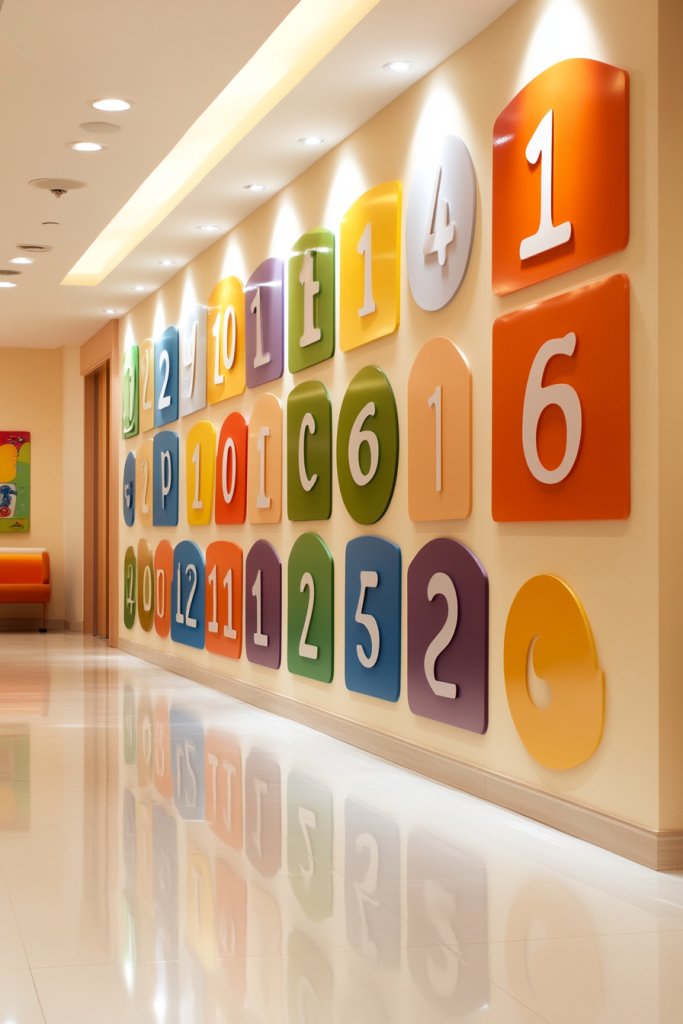
Kids love to learn, but keeping their interest while teaching basic skills can be a challenge. Plus, parents want a room that’s both fun and functional without cluttering every surface. Finding a way to incorporate education seamlessly into decor is a desire many parents share. This idea offers a simple solution that makes learning part of the room’s charm.
Imagine a bright wall adorned with colorful, large letters and numbers arranged playfully. The decals are easy to stick and remove, creating a lively, educational mural. The bold colors contrast beautifully with soft wall tones, making each letter and number pop. It’s like a mini classroom that doubles as a vibrant art piece, stimulating curiosity and engagement.
You can customize this concept with different themes—like jungle animals or space motifs—by choosing themed decals. For smaller rooms, arrange the alphabet vertically or in a corner to save space. Seasonal updates are easy—swap out decals for holiday themes or learning new words to keep things fresh. For older kids, use metallic or textured decals to add an extra stylish touch.
Start by selecting high-quality, repositionable wall decals designed for kids’ rooms. Measure your wall space and plan your layout, whether in a grid or freeform arrangement. Clean the wall surface thoroughly to ensure good adhesion. Carefully peel and stick each decal, smoothing out air bubbles to avoid wrinkles. For added durability, consider applying a clear, matte sealant over the decals to prevent peeling as kids explore.
Add personalized touches by including your child’s name or favorite words among the decals. Incorporate tactile elements like foam letters or textured numbers that kids can touch and explore. Use chalk markers on the wall for interactive spelling or math games, blending art with active learning. This creates a room that evolves with your child’s growing skills and interests.
This educational wall art makes the room lively and functional, fostering early learning naturally. It’s a simple way to boost your child’s curiosity while keeping the decor playful. Plus, a learning-focused environment sets the stage for confidence and a love of discovery that lasts. Ready to turn a blank wall into a playful classroom?
2. Colorful Floating Shelves for Toy and Book Storage
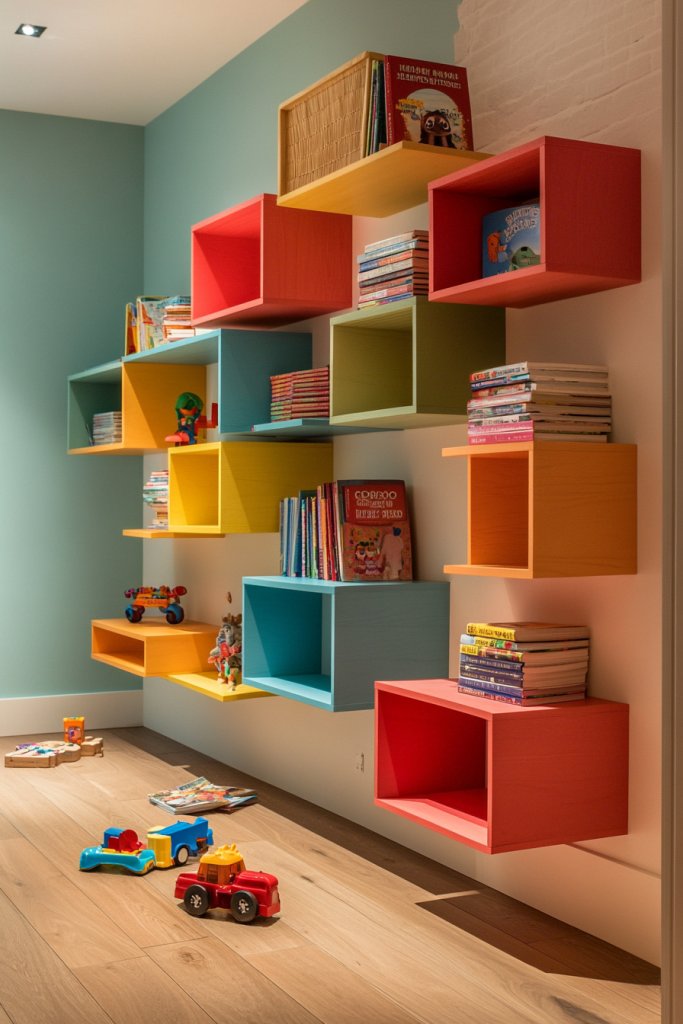
Toys and books tend to clutter small rooms, making everything look chaotic and hard to access. Parents want a simple, stylish way to keep essentials organized while adding visual interest. Floating shelves are a sleek solution that frees up floor space and displays items beautifully. They’re perfect for creating an organized, playful environment.
Imagine a set of vibrant, wall-mounted shelves in playful shapes or bright colors. They hold colorful bins, picture books, or decorative objects, creating a lively display. The shelves are positioned at kid-friendly heights, making it easy for little ones to grab their favorites. With a mix of open space and neatly arranged items, the room feels cheerful and organized.
Choose shelves in different colors or shapes—like clouds, stars, or geometric patterns—to match your decor. For small spaces, stagger shelves vertically to maximize vertical storage. Seasonal swaps are simple: replace toys with art projects or holiday decorations. For a minimalist look, opt for white or neutral-colored shelves that blend seamlessly into the room’s palette.
Start by measuring wall space and selecting sturdy, kid-safe floating shelves. Use a level and wall anchors for secure installation, especially if holding heavier items. Arrange the shelves at varying heights to add visual interest and accessibility. Decorate the shelves with a mix of toys, books, and decorative accents—just not too cluttered—to keep it functional. Regularly rotate items to keep the display fresh.
Personalize shelves with themed storage bins or labels that help kids learn organization. Incorporate decorative elements like framed photos, small sculptures, or DIY craft projects. Use the shelves to showcase seasonal items, encouraging children to participate in decorating. Keep accessibility in mind—placing favorite books and toys at their eye level helps foster independence.
Smart shelving transforms chaos into an attractive display, making tidying up feel rewarding. It boosts your child’s sense of responsibility and pride in their space. Plus, it’s a flexible system that adapts as their collection grows. Your tiny room can become a vibrant, organized haven—just add a splash of color and a dash of creativity!
3. Themed Wall Murals for Imaginative Adventures
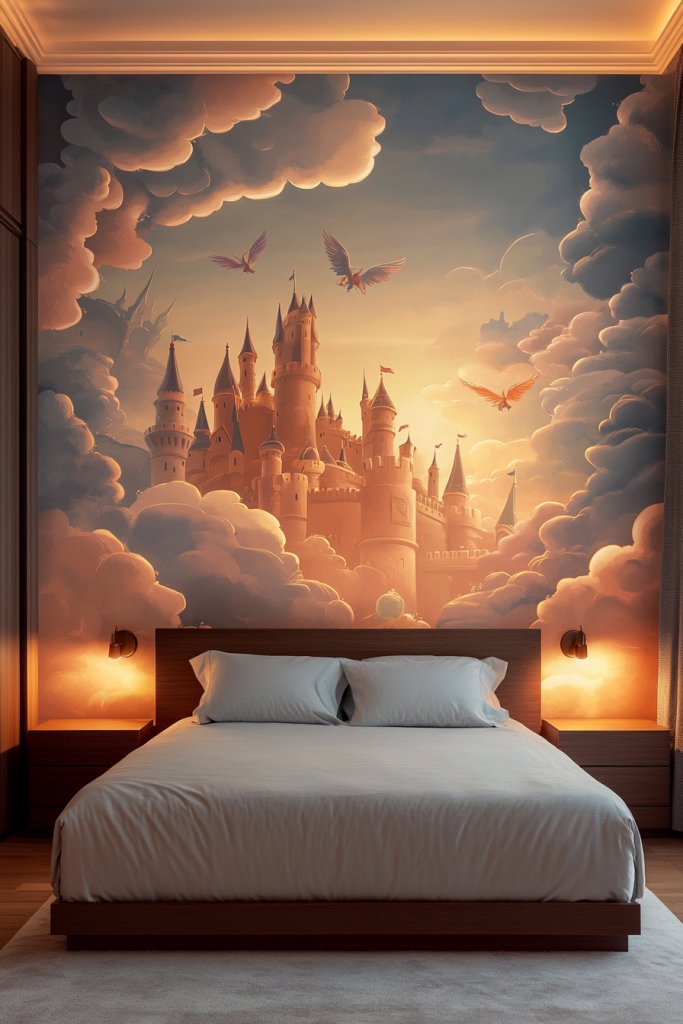
Kids have vivid imaginations, but boring walls can stifle their creativity. Parents want to inspire adventure and storytelling right in the bedroom. A themed wall mural transforms a plain wall into an immersive scene, sparking endless adventures. It’s a quick way to personalize a space that feels truly special.
Picture a large removable wallpaper depicting a lush jungle with playful animals or an underwater ocean scene with colorful fish and coral. The mural covers an entire wall, creating a captivating backdrop. Bright colors and whimsical designs make the room feel like a portal to another world, inviting kids to imagine themselves on adventures within the scene. The details engage their curiosity and inspire storytelling.
Choose murals based on your child’s favorite themes—space, fairy tales, pirates, or dinosaurs. For smaller rooms, focus the mural on one wall or a corner to create a feature. Seasonal or special occasion decals can also add a temporary themed touch. Combine murals with themed bedding or accessories for a cohesive look that evolves as your child grows.
Pick a high-quality, removable wallpaper or decals designed for easy application and removal. Prepare the wall by cleaning and smoothing out any imperfections. Carefully align the mural, smoothing out bubbles and wrinkles as you go. For a more permanent look, consider professional installation, especially for large or intricate designs. To protect the mural, avoid excessive moisture or abrasive cleaning.
Let your child contribute to the decor by adding small DIY elements like glow-in-the-dark stars or hand-painted accents. Incorporate themed accessories like plush animals or decorative pillows that match the mural scene. Change up the scene over time with new decals or layered stickers for ongoing engagement. This keeps the room feeling fresh and exciting.
A themed mural turns a simple room into a storytelling playground, encouraging creative play. It helps children develop their imagination and narrative skills effortlessly. Plus, it’s a striking feature that makes the space uniquely theirs. Ready to turn blank walls into portals of wonder?
4. DIY Fabric-Covered Pegboard for Art Supplies
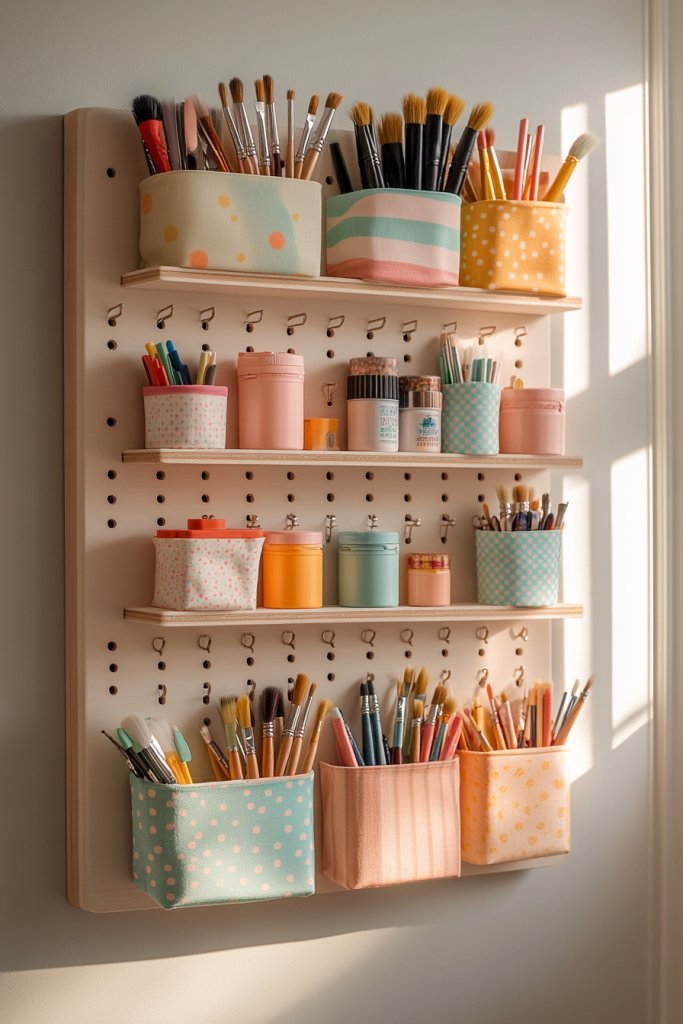
Messy art supplies can quickly turn a small space into chaos, making cleanup a nightmare. Parents want an organized, accessible way to store art materials that also encourages kids to be creative. A fabric-covered pegboard offers a customizable, stylish solution that keeps everything within reach. It’s a fun DIY project that doubles as decor.
Visualize a large pegboard painted in cheerful pastel or bold colors, covered with patterned fabric for added texture. Hooks and baskets hang from the grid, holding paints, brushes, scissors, and paper. The fabric adds softness and style, making the workspace inviting. Small fabric pockets can store smaller supplies, while clips hold artwork in progress. It’s an organized art station that’s also a charming wall feature.
Choose fabrics that match your room’s theme or season—bright florals, geometric prints, or calming solids. Adjust the pegboard size depending on available wall space. Incorporate additional elements like cork strips or small shelves for extra versatility. For portable use, attach the pegboard to a rolling cart or lightweight frame so it can be moved or stored easily.
Start by cutting a sturdy wooden board slightly larger than your pegboard grid. Cover the front with your chosen fabric, stretching tightly and securing with a staple gun or adhesive. Attach a pegboard panel over the fabric, ensuring hooks and baskets can be easily mounted. Organize art supplies by type, and encourage your child to participate in decorating the fabric with fabric markers or paint. Regularly update the arrangement as their collection grows.
Personalize with labels, tags, or themed fabric choices that reflect your child’s interests. Add small decorative elements like fabric bows or patches for extra flair. Incorporate a small chalkboard or whiteboard section for quick notes or doodles. Let your child decorate their art station to make it truly theirs, fostering ownership and pride.
A fabric-covered pegboard keeps art supplies organized and accessible, inspiring kids to create more often. It teaches responsibility and tidiness in a fun way. Plus, it adds a cozy, handmade touch to the room’s decor. Your child will love having a dedicated, stylish space to let their creativity run wild.
5. Multi-Functional Storage Ottoman for Extra Seating and Toy Storage
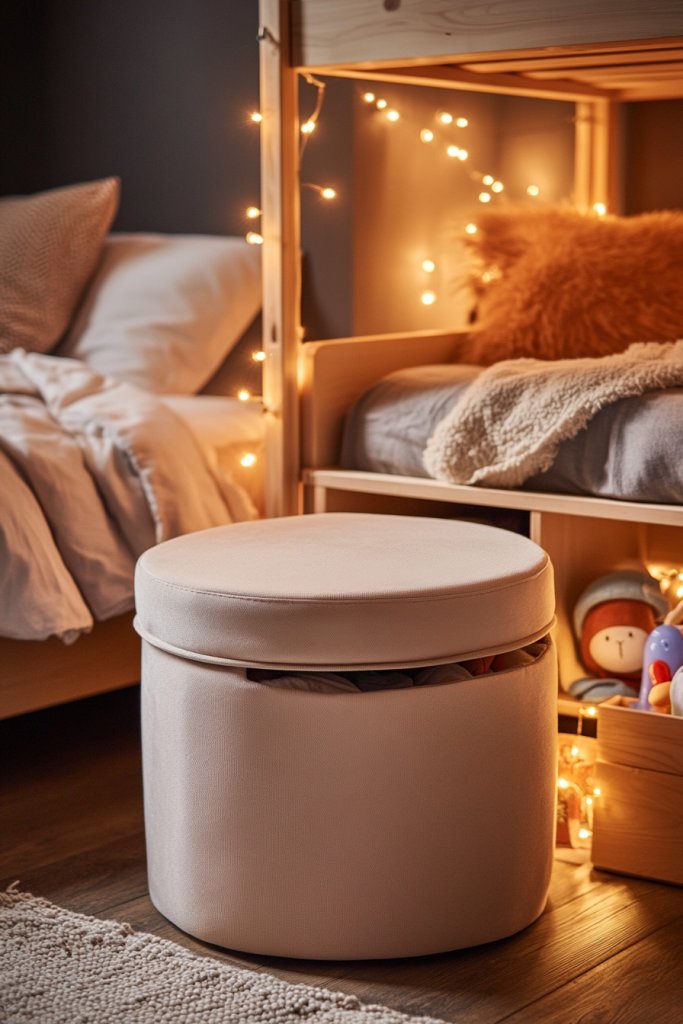
Small bedrooms often lack enough seating and storage, forcing kids to sit on the floor or clutter up the room. Parents want a versatile piece that serves multiple purposes without taking up extra space. A storage ottoman is an excellent solution that combines seating, organization, and style into one compact piece. It’s a win for smart, space-efficient living.
Visualize a colorful, plush ottoman with a soft, washable fabric cover. Its top opens easily to reveal a roomy interior filled with plush toys, blankets, or seasonal clothes. It doubles as a comfy seat when closed and a storage box when open. Positioned near a reading nook or under a window, it invites kids to sit and relax while keeping clutter out of sight. The vibrant colors add a playful pop to the room.
Select ottomans in various sizes, shapes, and colors to match your decor. For a more mature look, choose neutral tones with textured fabrics like chenille or faux leather. Consider adding wheels for easy mobility or a removable lid for cleaning. For themed rooms, opt for patterns or decals that reflect your child’s interests—like animals, stars, or sports. Seasonal covers allow easy updates without buying new furniture.
Choose a sturdy, child-safe ottoman with a hinged or lift-off lid. Measure the space where you plan to place it to ensure a proper fit. Use a soft, durable fabric for the cover, and secure it tightly with staples or adhesive if DIY. Keep the interior dry and clean by lining it with a washable liner or fabric. Fill it with lightweight, soft items that are easy to grab or replace.
Add personalized patches, embroidered initials, or themed fabric covers to make it unique. Incorporate small decorative pillows or cushions to transform it into a mini lounge. Use clear labels on storage compartments inside for quick tidying. Encourage your child to organize their toys or blankets regularly, making the ottoman a part of daily routines.
This multi-purpose piece helps teach responsibility while offering a cozy spot to relax. It makes the room feel more welcoming and functional. Plus, it’s a simple project that you can customize together, fostering pride and ownership. Ready to upgrade your kid’s room with style and smart storage?
6. Bright Geometric Rug to Define Play Zones

Small rooms often lack clear zones for sleeping, playing, and studying, making the space feel chaotic. Parents want to create designated areas that feel cohesive yet fun. A bold geometric rug can anchor these zones visually and functionally. It adds color and pattern, transforming a plain floor into a playful hub.
Imagine a large, vibrant rug with bold triangles, squares, or abstract shapes in contrasting colors. It covers a sizable part of the floor, instantly defining the play area. The textured surface feels soft underfoot, perfect for tumbling or sitting. Bright hues like teal, yellow, and coral energize the room, making it feel lively and inviting. The geometric pattern adds a modern, artistic touch.
Choose rugs with different shapes or sizes to match your room’s layout. For a subtle look, opt for muted tones and simple patterns; for a bold statement, go for striking contrasts or multi-color designs. Layer rugs for visual interest or create separate zones with different patterns. Seasonal accessories like plush toys or cushions can complement the rug and refresh the space.
Select a non-slip, washable rug made from durable, kid-friendly materials. Measure your space carefully to choose the right size—large enough to define the zone but not overwhelm the room. Lay it flat on a clean, even surface and secure edges with non-slip pads if needed. Use the rug as a base for play mats, small furniture, or activity stations. Clean regularly to keep it fresh and inviting.
Coordinate the rug’s colors with your overall decor theme. Add themed cushions, stuffed animals, or DIY fabric banners nearby to reinforce the playful vibe. Change accessories seasonally or as your child’s interests evolve. You could even create a custom design or initials to make it more personalized. This approach guarantees a lively, personalized space.
A bright geometric rug creates a focal point that encourages active play and organization. It helps children associate specific areas with different activities, boosting independence. Plus, it’s a simple upgrade that instantly energizes the room. Ready to add a splash of color and pattern to your tiny space?
7. Hanging Rope Swing or Seat for Cozy Nooks
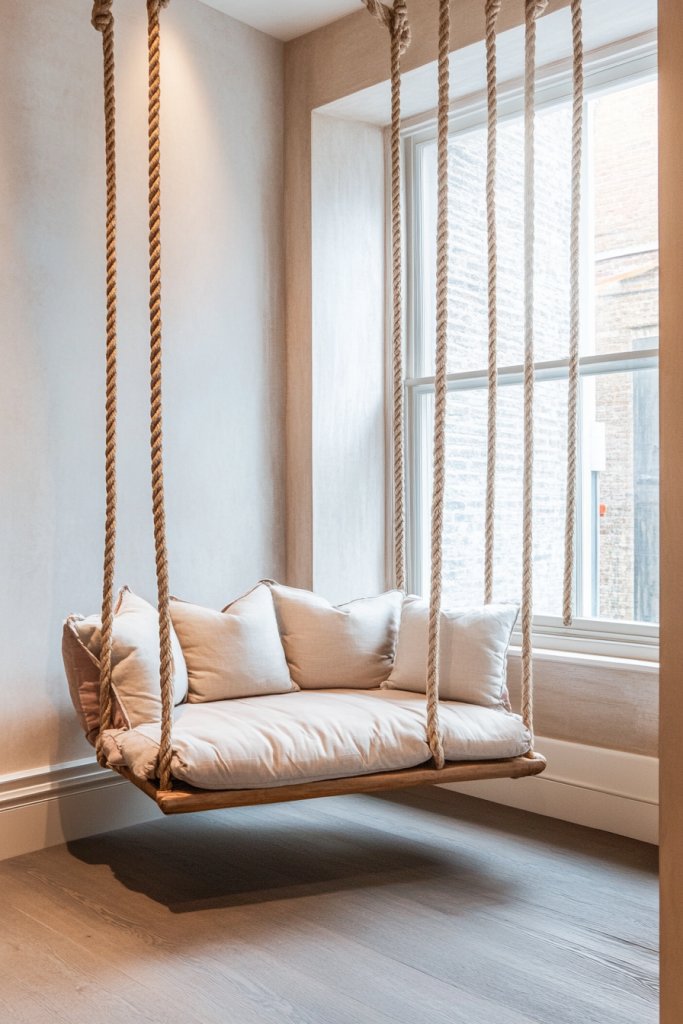
Kids need their own cozy corners for quiet time, reading, or imaginative play. Small bedrooms often lack dedicated nooks, making it hard to find a special retreat. A hanging rope swing or seat offers a fun, space-saving solution that transforms a corner into a whimsical hideaway. It’s a playful way to add personality and function.
Picture a sturdy, colorful rope swing suspended from the ceiling, with a soft cushion or bean bag seat. It hangs just low enough for easy access and is secured with strong anchors. Nearby, a small shelf or hanging mobile adds charm without cluttering the space. The swing’s playful movement invites kids to relax, read, or daydream, turning a corner into a mini sanctuary full of magic.
Choose swings in bright hues or natural fibers to match your decor. For smaller rooms, opt for a compact seat or a hanging basket instead of a large swing. Add a canopy or fabric drapes around the nook for privacy and a cozy atmosphere. Seasonal accessories like fairy lights or plush cushions can make it more inviting and personalized.
Select a ceiling hook rated for the weight and size of the swing. Measure the ceiling height and ensure enough clearance for safe swinging. Use strong, secure anchors and test support before kids use it. Attach a soft cushion or small mattress for comfort, and add safety features like soft padding around the anchor points. Regularly check the hardware for stability.
Decorate the area with themed fabrics, DIY banners, or wall decals nearby. Let your child pick the colors or add their name to personalize the space. Incorporate soft lighting like battery-operated lanterns or fairy lights to create a magical atmosphere. Encourage imaginative play by adding related toys or books in the nook.
This cozy corner boosts relaxation and independent play, helping kids unwind and feel special. It adds a unique feature that makes the room memorable and fun. Plus, it encourages physical activity and a sense of adventure. Ready to swing into a playful, cozy retreat?
8. Tiered Toy Organizer with Color-Coded Bins
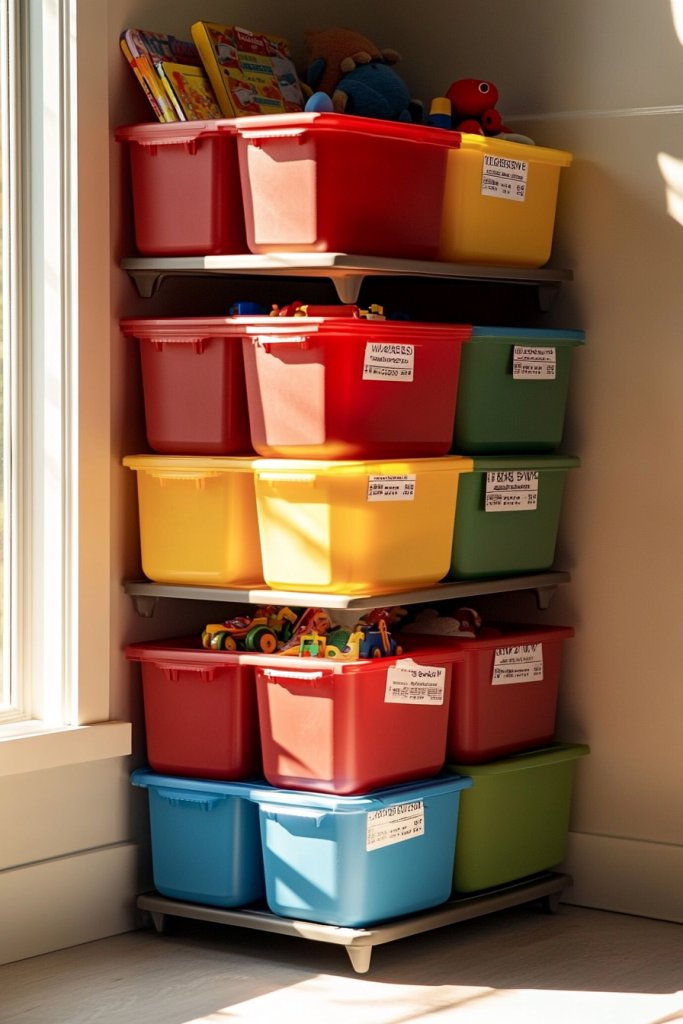
Toy clutter can quickly turn a small room into chaos, making it hard for kids to find what they want and clean up afterward. Parents seek a storage system that’s both organized and visually appealing. Tiered organizers with color-coded bins make tidying up simple and fun, while adding a cheerful vibe. It’s a practical solution for keeping a small space neat.
Picture a tall, multi-tiered shelf with bright, labeled bins in different colors—red, blue, yellow, green—each holding different toy categories. The open design allows kids to see everything at a glance and pick their favorites easily. The vibrant colors contrast against neutral walls, making the room look lively and inviting. The different levels help maximize vertical space, keeping toys off the floor.
Choose bins with removable lids or open tops based on your child’s preferences. For smaller rooms, stack the tiers vertically or opt for a single unit with fewer levels. Labels or icons on bins help kids learn organization skills. You can also customize the look by choosing bins in your child’s favorite colors or themes—superheroes, animals, or abstract patterns.
Select a sturdy tiered shelf that fits your space, ensuring stability and safety. Use bins made of durable, washable plastic or fabric. Label each bin with words or pictures for easy identification, and encourage your child to sort their toys regularly. Position the organizer in a central area or near the play zone for convenience. For added fun, let your kid decorate or personalize the labels.
Let your child participate in choosing colors or themes for the bins, fostering ownership. Use themed labels or stickers for added personality. Incorporate small decorative elements like plush toys or themed decor around the organizer to tie it into the room’s style. Teach your child to put toys away after playtime—turn tidying into a game.
A well-organized toy system promotes responsibility and independence. Kids learn to keep their space tidy, which boosts confidence and pride. It also makes cleanup quicker and less of a chore, giving more time for fun. Your room will look tidier and more inviting—ready for the next adventure!
9. Cozy Tent or Teepee for Secret Hideouts
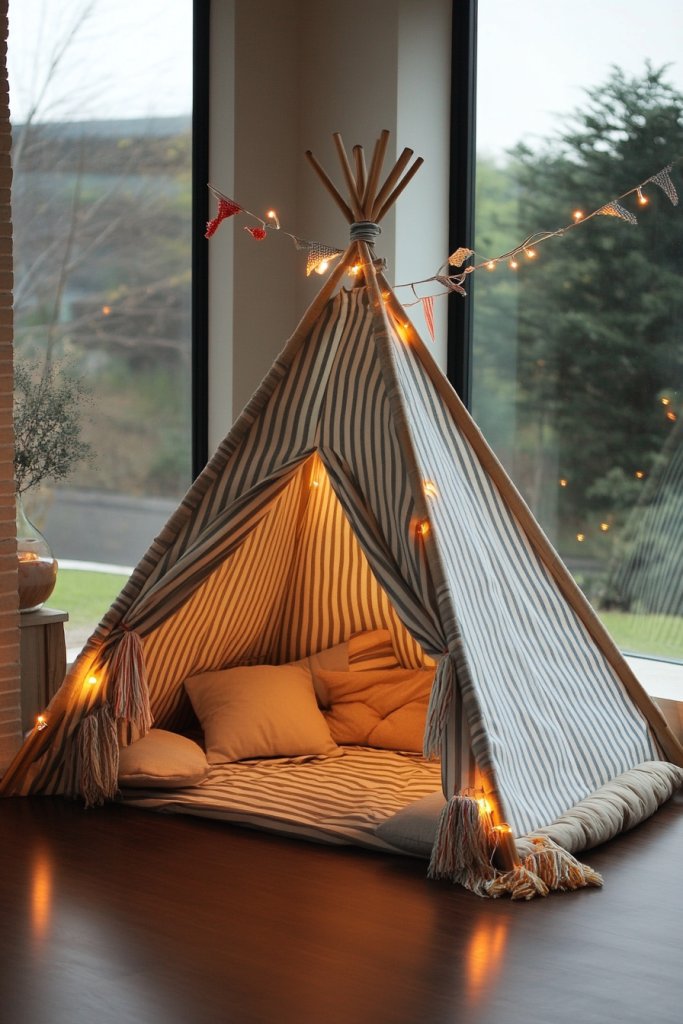
Kids crave their own special hideouts where they can escape, imagine, and play freely. Small bedrooms often lack dedicated nooks for private play, leading to clutter and shared spaces. A cozy tent or teepee creates a magical retreat without taking up much room. It’s a simple DIY or store-bought fix that sparks joy and creativity.
Imagine a colorful fabric teepee with whimsical patterns, set up in a corner of the room. Inside, soft cushions, fairy lights, and stuffed animals create an inviting space. The fabric’s texture adds warmth, while the playful design sparks imagination. Kids can use it for reading, storytelling, or quiet time, feeling like they’ve stepped into their own fairy tale world. It’s a charming focal point that transforms the room.
Choose fabrics and patterns that match your decor or your child’s favorite themes—pirates, princesses, or space explorers. For smaller rooms, opt for a compact, collapsible tent that can be tucked away when not in use. Add decorative elements like banners, fairy lights, or themed cushions to personalize it. For older kids, incorporate a small table or storage inside for crafts or books.
Buy a ready-made teepee or DIY with fabric, wooden dowels, and a simple sewing kit. Set up in a corner, anchoring the fabric securely to prevent wobbling. Decorate the interior with cushions, fairy lights (battery operated for safety), or themed accessories. Make sure the fabric is breathable and easy to clean. Encourage your child to help decorate, making it a shared project.
Add themed accessories like banners, wall decals, or customized name signs to make it uniquely theirs. Incorporate small baskets or boxes inside for toys or books. Change the decor seasonally to keep the hideout exciting—think holiday-themed or color swaps. Let your child decorate with their drawings or favorite stickers to foster ownership.
A cozy hideout nurtures independence and imaginative play, boosting confidence. It teaches kids to create their own special spaces and feel safe and in control. Plus, it’s a delightful feature that makes the bedroom memorable and fun. Ready to build your child a secret haven?
10. Playful Wall Hooks in Fun Shapes
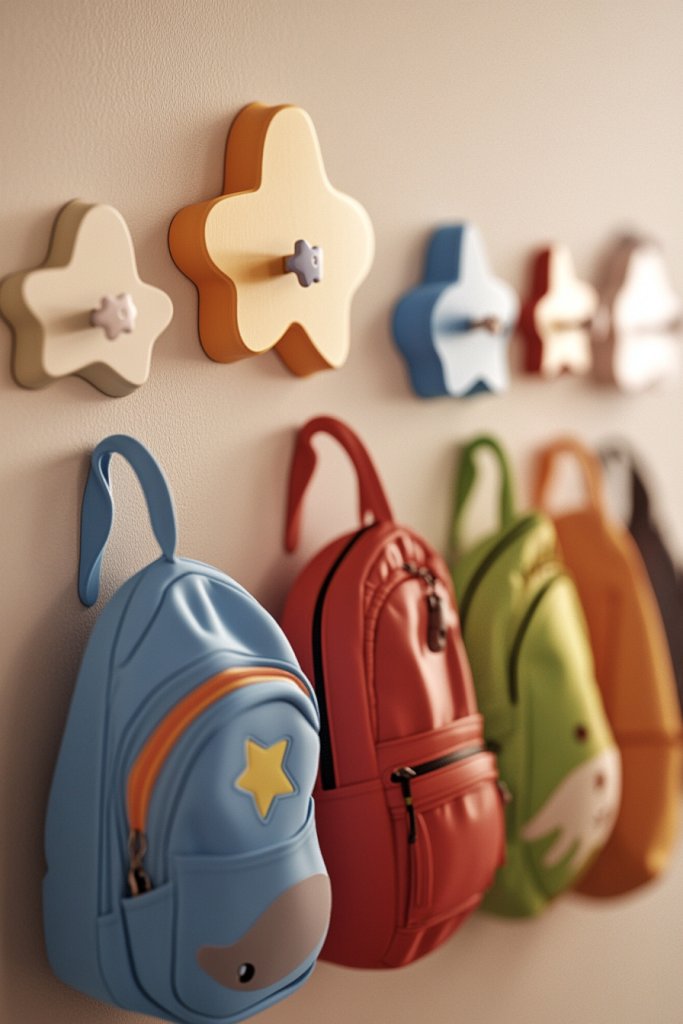
Cluttered rooms often have clothes, backpacks, and accessories strewn across furniture or the floor. Kids need an easy, fun way to keep their essentials off the ground. Playful wall hooks in shapes like animals, stars, or clouds turn functional storage into decorative art. It’s a simple upgrade that encourages tidiness and adds charm.
Picture a series of hooks shaped like smiling clouds, energetic stars, or friendly animals, mounted at kid-friendly heights. They hold backpacks, jackets, or hats, immediately transforming a blank wall into a lively feature. The bright colors and whimsical designs make organizing feel like playtime. The hooks are sturdy yet lightweight, blending practicality with fun.
Choose hooks in diverse shapes and sizes to match your decor or your child’s favorites. For smaller spaces, cluster hooks in a grid or zigzag pattern. For themed rooms, select matching sets—dinosaurs, princesses, or sports icons. Mix and match materials like wood, plastic, or metal for texture. Seasonal updates with new shapes or colors keep the display fresh.
Start by measuring wall space and selecting hooks rated for the intended weight. Use a level and appropriate anchors to secure hooks firmly. Arrange hooks at varying heights for visual interest and accessibility. Hang lightweight items first, then test with heavier ones. Regularly check hardware for stability and replace worn hooks to maintain safety.
Personalize hooks with your child’s name or favorite characters using decals or paint. Create a themed display—like a jungle or space station—by coordinating hooks and accessories. Encourage your child to decorate or rearrange hooks as they grow. Add small baskets or fabric pouches for additional storage that complements the hooks.
Fun hooks make tidying up an enjoyable routine and foster independence. Kids learn responsibility while adding a playful touch to the room. It’s an easy way to keep essentials organized and accessible. Ready to add personality and order to your child’s space?
11. DIY Painted Mason Jar Wall Sconces for Soft Lighting
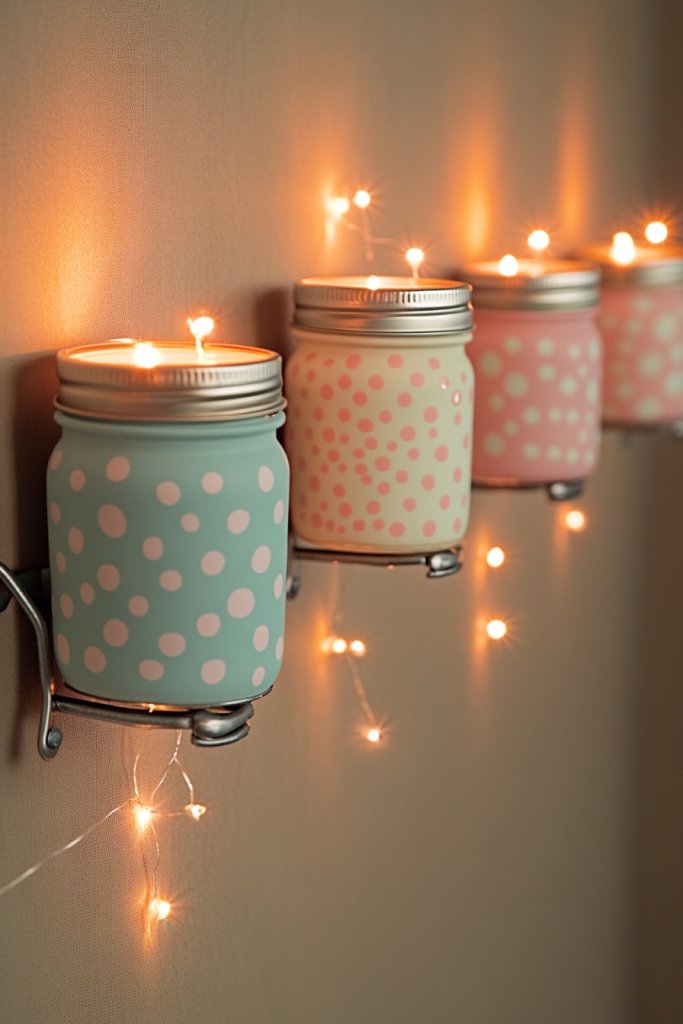
Kids need cozy, soothing lighting for bedtime or quiet time, but generic lamps can be dull or space-consuming. Parents seek affordable, creative ways to add warmth without clutter. DIY painted mason jar sconces offer a charming, budget-friendly solution that adds soft ambient light. It’s a project that combines style with practicality.
Visualize a set of mason jars painted in pastel or metallic hues, mounted on the wall with simple brackets or hooks. Inside, string lights or battery-operated candles create a gentle, flickering glow. The jars are decorated with painted patterns, washi tape, or decals that match the room’s decor. The soft light filters through the glass, creating a calming atmosphere perfect for winding down.
Choose jar colors and patterns based on your theme—wildflowers, celestial, or nautical. For a minimalist look, keep the paint simple or clear. Use different jar sizes or cluster multiple sconces for visual interest. Incorporate natural elements like twine or fabric ribbons for extra texture. Seasonal or holiday-themed jars add versatility.
Paint the mason jars with weatherproof or acrylic paints, letting each coat dry thoroughly. Attach hooks or brackets to the wall at desired heights. Insert string lights or LED candles, ensuring safety and ease of access. Secure the jars to the hooks with wire or twine, decorating with additional ribbons or charms. Switch out the lights or decorations as needed.
Personalize jars with your child’s name or favorite patterns. Incorporate themed paint designs or decals to suit holidays or seasons. Use the jars to hold small toys, stationery, or keepsakes, blending utility with decor. Encourage your child to decorate or help paint for a fun DIY activity. It’s a cozy, personalized lighting feature that lasts.
This project offers a creative outlet while providing gentle lighting that helps kids feel safe and relaxed. It teaches DIY skills and boosts confidence as they see their handiwork illuminating their space. Plus, it’s a charming, budget-friendly upgrade that makes the room special. Ready to craft your own soft glow?
12. Bright, Modular Cubic Shelving for Flexible Storage
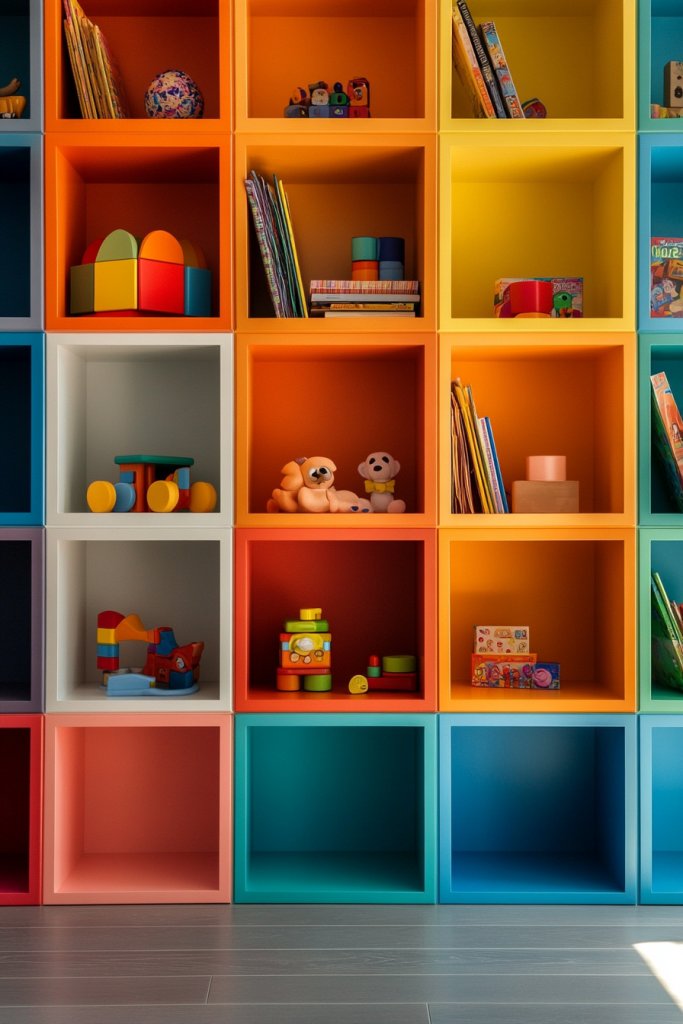
Rooms often need adaptable storage that can grow or change with your child’s needs. Fixed shelves may limit options or become cluttered quickly. Modular cubic shelving offers a flexible, colorful solution that can be reconfigured easily. It’s perfect for small spaces needing dynamic organization.
Imagine a set of vibrant, cube-shaped shelves in primary or pastel colors stacked or arranged in different configurations. They hold books, toys, or decorative items, creating a playful geometric display. The modular design allows you to add or remove units as needed, making the setup uniquely yours. The bright colors energize the room and keep everything within reach.
Choose cubes in various sizes or colors to suit your style, from bold to subdued. Stack them vertically or arrange in grid patterns for visual impact. For a more mature look, opt for sleek, neutral tones with colorful bins inside. Use them for different functions—study zones, display areas, or toy storage—adapting as your child grows.
Select sturdy, lightweight cubes made from durable plastic, wood, or MDF. Secure the units with connectors or brackets for stability, especially if stacking high. Organize items in labeled bins or baskets inside the cubes. Mount the entire setup on the wall for safety, or keep it free-standing. Regularly reconfigure as your child’s interests and needs evolve.
Decorate the cubes with washi tape, stickers, or paint for a personalized touch. Use themed bins or inserts to match hobbies or interests—sports, arts, or animals. Incorporate a few small decorative elements around the shelves to make the space inviting. Let your child help decorate or choose configurations for a sense of ownership.
This flexible shelving system fosters organization skills and independence. Kids learn to manage their belongings and adapt the space as they grow. It’s also a space that can evolve with their changing tastes and hobbies. Ready to create a colorful, adaptable storage solution?
13. Floating Desk with Built-In Storage for Homework and Crafts
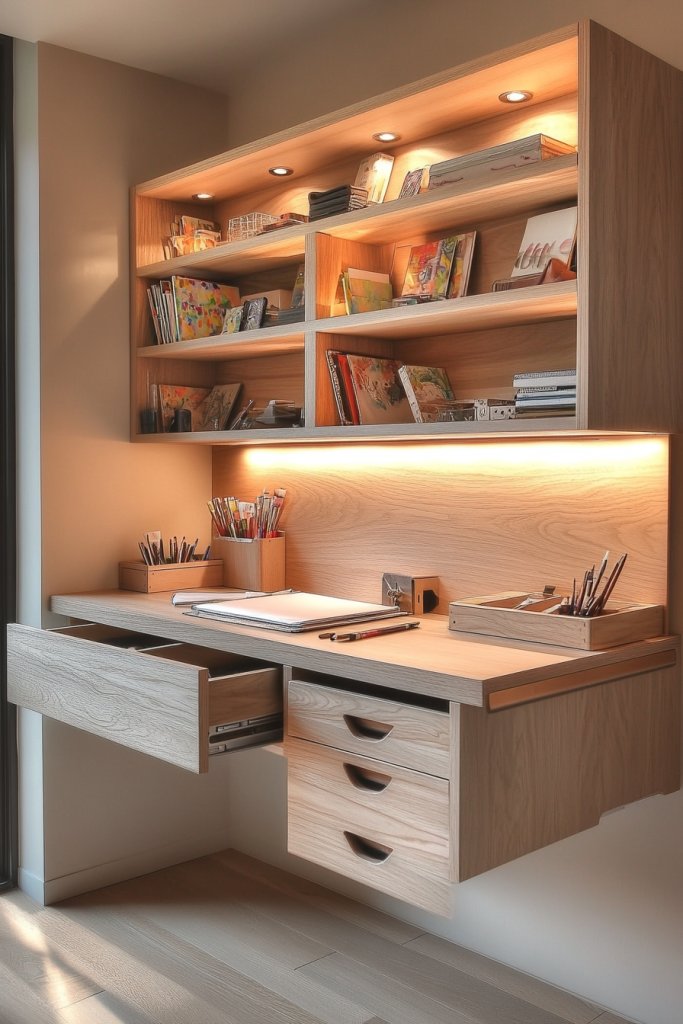
Small bedrooms often lack dedicated, organized spaces for homework and creative projects, leading to clutter and distraction. Parents want an efficient, space-saving solution that encourages focus and neatness. A floating desk with built-in storage offers a sleek, practical answer. It transforms a corner into a productive zone without sacrificing precious floor space.
Picture a slim, wall-mounted desk in a bright color or neutral finish, with drawers and shelves integrated directly underneath. The surface provides enough room for a laptop, books, or art supplies. The storage compartments keep pencils, papers, and small tools organized and out of sight. The clean design keeps the room feeling open, while the functional layout supports focus and creativity.
Choose a minimalist desk with hidden or open storage based on your style. For small rooms, opt for a fold-down or drop-leaf design that can be tucked away when not in use. Incorporate colorful bins or decorative handles for a playful touch. For older children, add adjustable shelves or a corkboard for personalization. Match the desk with your existing decor for a cohesive look.
Mount the desk securely to the wall at the appropriate height. Use sturdy brackets and anchors, especially if supporting heavier items. Organize supplies in the built-in drawers or on the shelves, labeling where necessary. Add a comfortable chair or cushion for sitting. Keep cords and chargers tidy with clips or cable organizers. Regularly declutter to maintain an inspiring workspace.
Decorate the front with stickers, decals, or a fun paint pattern. Personalize storage with labels or themed handles. Incorporate a small pinboard or magnetic strip above for notes and artwork. Encourage your child to keep the area tidy and decorate it with their favorite colors or motifs. It’s a dedicated space that promotes responsibility and pride.
A floating desk nurtures focus, creativity, and independence, making homework less of a chore. It teaches organizational skills in a space-efficient way. Plus, it’s a modern, stylish feature that enhances the room’s look. Your child will love having a designated spot to learn and create—ready to upgrade your space?
14. Playful Wall Decals for Instant Theming
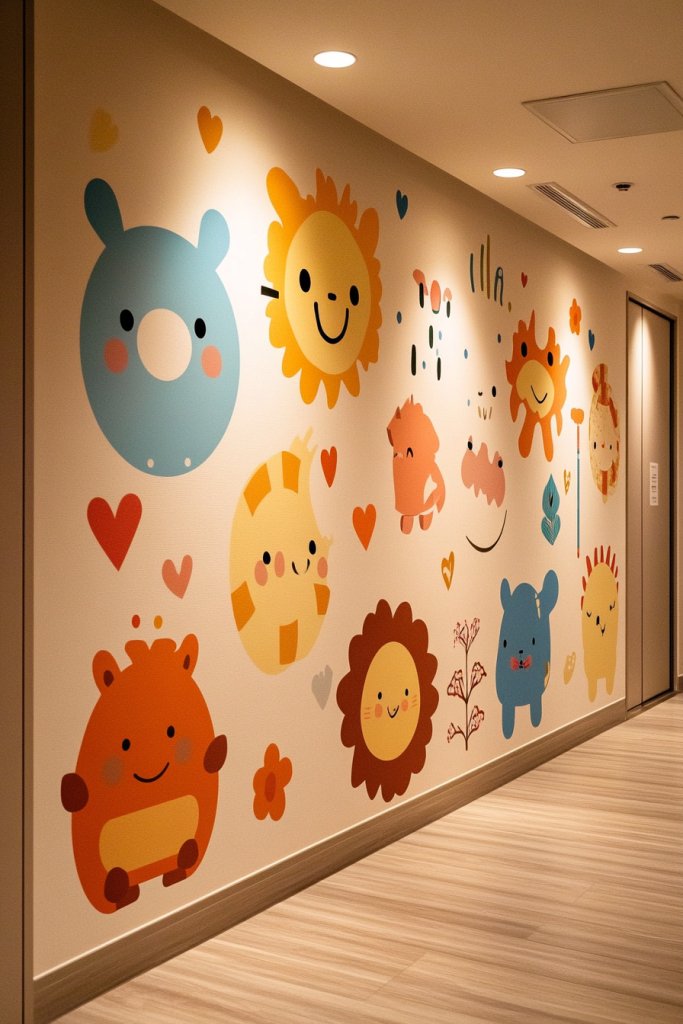
Bored walls can make a room feel dull, especially when your child’s interests change quickly. Parents want a way to personalize and refresh the space without major renovations. Playful wall decals offer an easy, affordable solution that transforms the room instantly. They’re perfect for creating themes that reflect your child’s current favorites.
Imagine removable, vibrant decals featuring animals, superheroes, or abstract shapes arranged dynamically on the wall. They can be repositioned easily, allowing for frequent updates. The decals add visual interest and personality, making the room feel lively and personalized. Bright colors and fun designs turn plain walls into a storytelling canvas that kids love.
Choose decals based on your child’s current interests—princesses, dinosaurs, or space themes. For a subtle look, opt for monochrome or pastel decals; for maximum impact, use bold, contrasting colors. Combine decals with themed bedding or furniture for a cohesive look. Seasonal or holiday decals can be swapped out to keep the decor fresh and engaging.
Select high-quality, removable decals designed for easy application and removal. Clean the wall thoroughly before applying, and use a level for precise placement. Arrange decals in clusters or patterns, depending on your style. For larger designs, follow manufacturer instructions carefully to avoid air bubbles. Regularly check and reposition decals as your child’s interests evolve.
Let your child participate by choosing their favorite decals or creating custom arrangements. Add small accessories or DIY elements like fabric banners or paper crafts that match the decal theme. Incorporate personal touches such as initials or favorite quotes. These updates keep the room exciting and reflect your child’s personality.
Decorating with decals boosts kids’ confidence and sense of ownership in their space. It’s a fun, easy way to keep their environment fresh and inspiring. Plus, it encourages their creativity and decision-making skills. Ready to turn plain walls into a vibrant storybook?
15. Vertical Garden of Faux Plants for a Touch of Nature
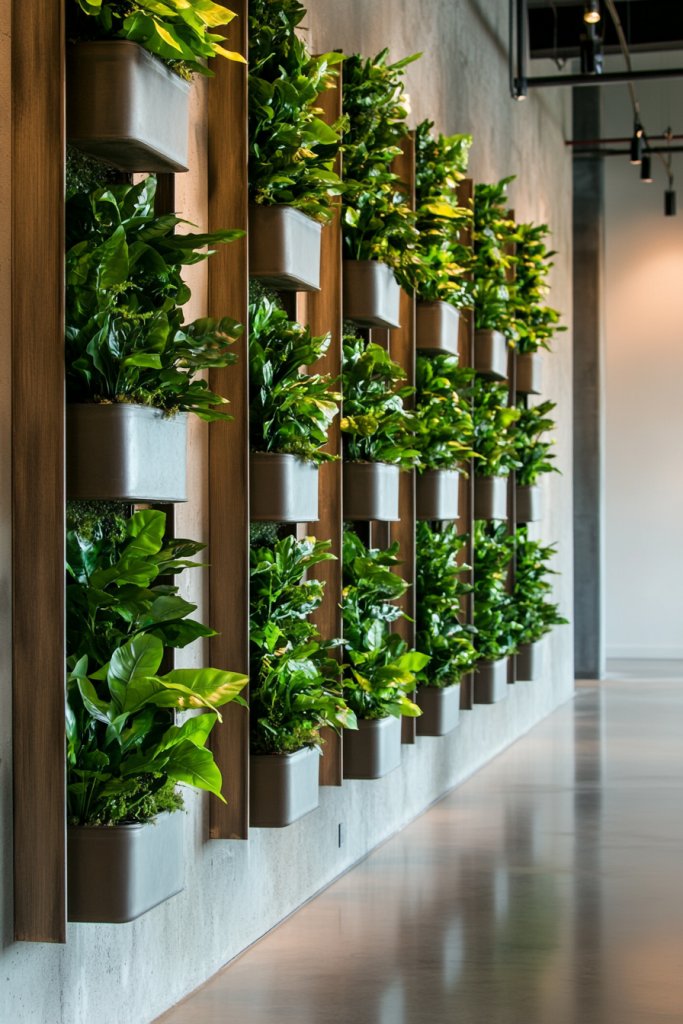
Bringing nature indoors is a big trend, but real plants can be tricky with kids and limited space. Parents want a touch of greenery that’s safe, low-maintenance, and space-efficient. Faux plants provide a realistic, decorative alternative that adds a calming vibe without the fuss. They’re perfect for small bedrooms where every inch counts.
Picture a wall-mounted panel with an array of faux greenery—ferns, succulents, or trailing vines—in decorative planters or hanging pots. The lush, textured foliage adds depth and a natural feel to the space. The greenery softens the room’s look and improves the ambiance, making it feel fresh and lively. The plants require no watering or sunlight, making maintenance a breeze.
Choose faux plants in different shades of green or with colorful flowers for extra vibrancy. Arrange them vertically or cascade from shelves or wall pockets. For a more cohesive look, select a theme—like tropical or woodland. Incorporate decorative pots or baskets to match your decor style. Change the arrangement seasonally or when your child’s tastes evolve.
Select high-quality, realistic faux plants that are easy to install—using hooks, adhesive strips, or wall pockets. Arrange them at varying heights for visual interest. Secure the planters firmly to prevent accidents and ensure safety. Clean the foliage occasionally with a damp cloth to maintain their fresh appearance. Keep the display simple and uncluttered for maximum impact.
Add small decorative stones or fairy lights around the faux plants for extra charm. Incorporate themed planters—like animal-shaped pots or colorful containers—to enhance personalization. Encourage your child to help arrange the greenery, fostering a sense of responsibility. Use the greenery as a calming focal point during stressful times or homework sessions.
A faux greenery wall adds a natural touch that’s easy to maintain, creating a peaceful environment. It teaches kids about nature and responsibility without the upkeep. Plus, it’s a stylish feature that boosts the room’s overall vibe. Ready to bring a little outdoor serenity inside?
16. Multi-Layered Bed with Built-In Storage and Play Area
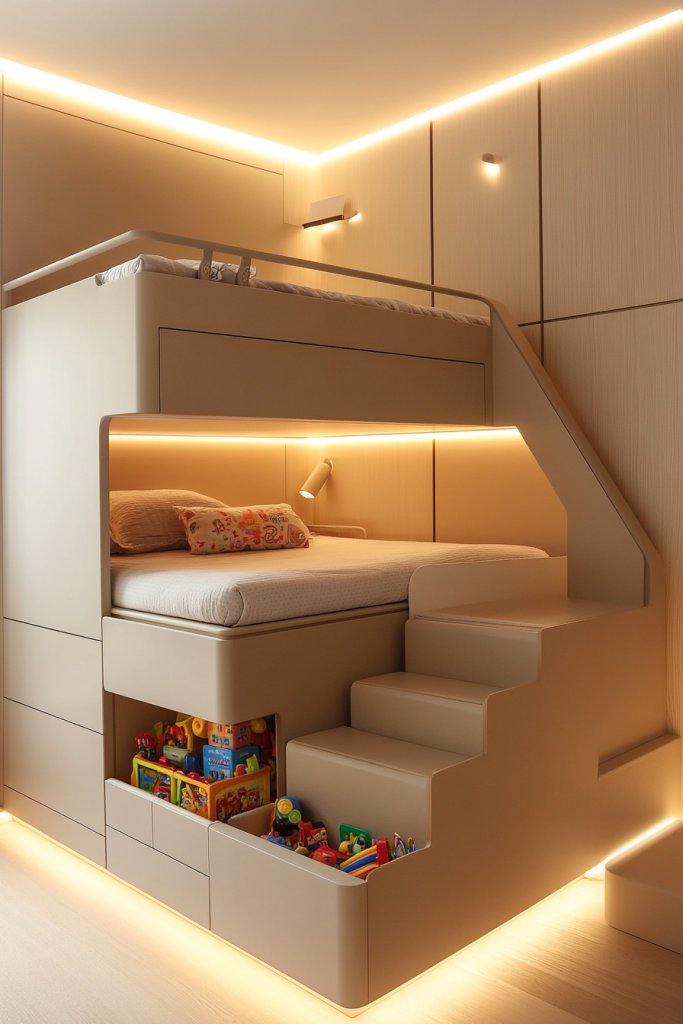
Small bedrooms often lack space for both sleep and play, leading to clutter and limited functionality. Parents want a bed that offers more than just a place to sleep. A multi-layered bed with built-in storage and a play zone underneath maximizes vertical space and makes the room versatile. It’s a clever way to keep everything organized and fun.
Imagine a low-profile bed with drawers and shelves integrated into the frame, with a cozy play area underneath. The play zone can include a small tent, cushions, or a foam mat, creating a secret hideout or activity corner. The design uses bright, cheerful colors and smart storage solutions to keep clutter out of sight. It’s a compact, fun environment that invites both rest and adventure.
Opt for a bed with a minimal or themed frame—like a castle or spaceship—depending on your child’s interests. Use colorful storage drawers or baskets that blend with the decor. For smaller rooms, choose a low bed with a fold-out or slide-out play area. Incorporate removable or adjustable features to grow with your child. Seasonal accents like themed bedding or decals personalize the space further.
Choose a sturdy, safety-certified bed frame with integrated storage options. Measure your space carefully to ensure enough clearance underneath for play and storage. Install drawers or shelves securely, and organize items by category. For the play area, add cushions, soft mats, or lightweight tents. Keep the design simple for easy cleaning and maintenance. Regularly declutter and update storage as needed.
Decorate the play zone with themed accessories—like space decals or fairy lights—and involve your child in the process. Use colorful bins and labels inside the storage areas for easy tidying. Add personal touches such as your child’s artwork or favorite characters. Seasonal or holiday-themed decorations make the space fun and inviting throughout the year.
This multi-layered setup encourages independence, creativity, and organization. Kids learn to manage their belongings and enjoy a space that’s both restful and playful. It makes the most of limited space while creating a magical environment. Ready to turn your tiny room into a multi-functional wonderland?
17. Compact Reading Nook with Cushions and Shelves
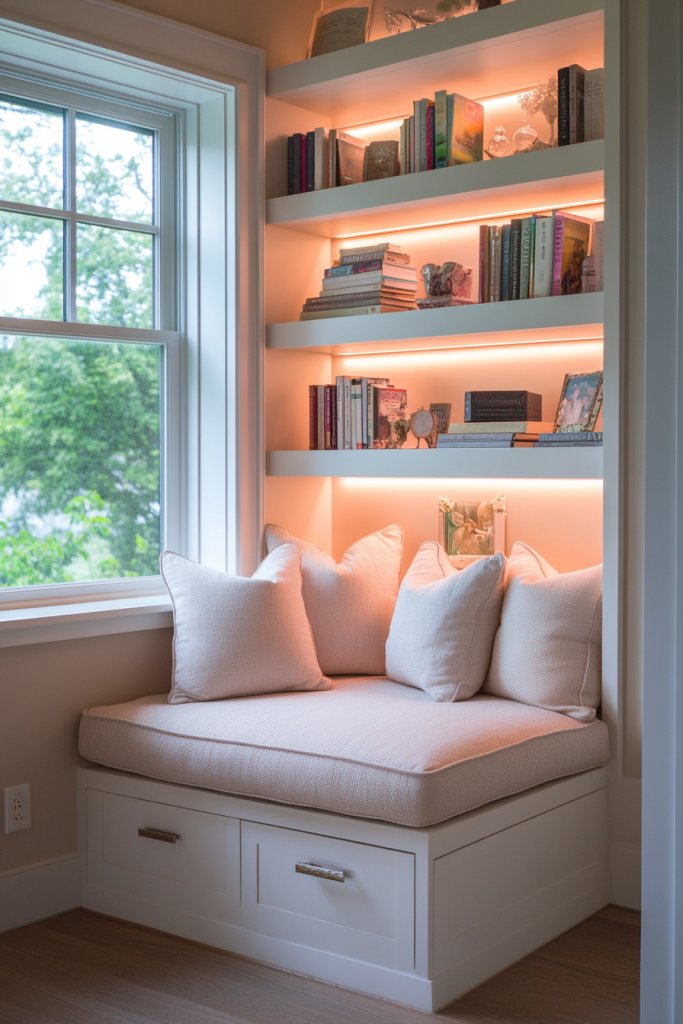
Kids need a quiet, cozy corner for reading and relaxing, but small bedrooms often lack dedicated space. Parents want a designated spot that’s inviting and easy to access. A compact reading nook with cushions and shelves creates a private retreat that encourages literacy and calm. It turns a corner into a personal sanctuary.
Imagine a small alcove or corner transformed with soft cushions, a plush rug, and a few shelves holding favorite books. The cushions are in bright, cheerful fabrics, inviting kids to sit and read for hours. Wall-mounted shelves above or nearby keep books organized and within reach. The space feels warm, welcoming, and perfectly suited for quiet moments of escape.
Choose cushions in fun patterns or colors that match the room’s theme. For smaller spaces, build a low bench with storage underneath or a corner of floor cushions. Incorporate fairy lights or a small canopy for added coziness. For older kids, add a small reading lamp or a fold-down table for snacks or writing. The design can be customized to suit interests and age.
Select a corner with enough space for cushions and shelves. Install low-profile shelving or wall-mounted units to save floor space. Fill the shelves with age-appropriate books and decorative elements. Add cushions and a soft rug to create a comfy seating area. Keep the area tidy with baskets or bins for quick cleanup. Encourage daily reading habits.
Personalize with your child’s favorite colors, characters, or themes—adding decals, banners, or themed cushions. Let them choose books and decor for their nook, fostering ownership. Incorporate a small bulletin board or picture frame for favorite quotes or drawings. Seasonal accessories keep the space fresh and engaging. It’s a special retreat tailored just for them.
A dedicated reading nook nurtures a love of books and quiet reflection. It builds confidence in their ability to create a space they love. Plus, it makes reading a cherished daily routine. Your child will feel proud of their cozy corner—ready to explore worlds within pages.
18. Magnetic Wall Panel for Creative Play and Organization
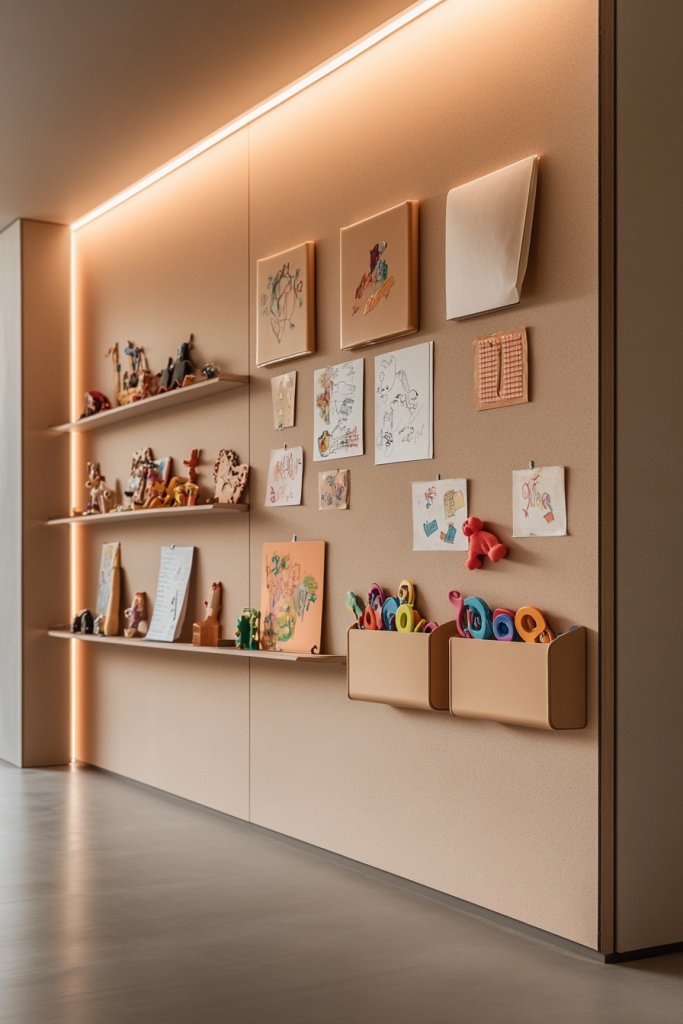
Messy, unorganized art supplies, notes, and small toys make small rooms feel cluttered and chaotic. Parents want a versatile, space-efficient way to display and organize these items. A magnetic wall panel offers a fun, interactive surface that’s perfect for creativity and tidiness. It’s a simple upgrade that makes a big difference.
Picture a sleek metal or painted panel mounted on the wall, dotted with colorful magnets holding artwork, notes, or small accessories. Kids can easily attach and rearrange items, creating their own display or gallery. The panel’s surface invites playful interactions and can serve as a message board or art station. It’s both functional and decorative, adding a modern touch.
Choose a panel in a bright color or metallic finish to match your decor. Use themed or shaped magnets—stars, animals, or letters—to add personality. Combine with other organizational tools like hooks or cork strips for variety. Adjust size and placement based on your space and needs. Seasonal or themed magnets make updates fun and easy.
Mount the panel securely at a reachable height for your child, using appropriate anchors. Keep a collection of magnets in different shapes and colors for versatility. Use it for displaying artwork, reminders, or small toys, and teach your child to clean up or rotate items regularly. Clean the surface with a damp cloth to maintain magnet adhesion. Incorporate it into a broader organizational system.
Decorate the magnetic surface with fun decals or borders. Use custom magnets shaped like your child’s favorite characters or themes. Encourage your child to decorate and curate their display, fostering independence. Incorporate small baskets or clips for additional storage or display options. It’s a personalized, interactive feature that celebrates their creativity.
A magnetic wall panel makes organization playful and empowering. Kids learn to manage their belongings and express themselves creatively. It’s a dynamic feature that keeps the room lively and personalized. Ready to turn a blank wall into a magnetic art and organization hub?
19. Reversible Wall Panels for Changing Themes
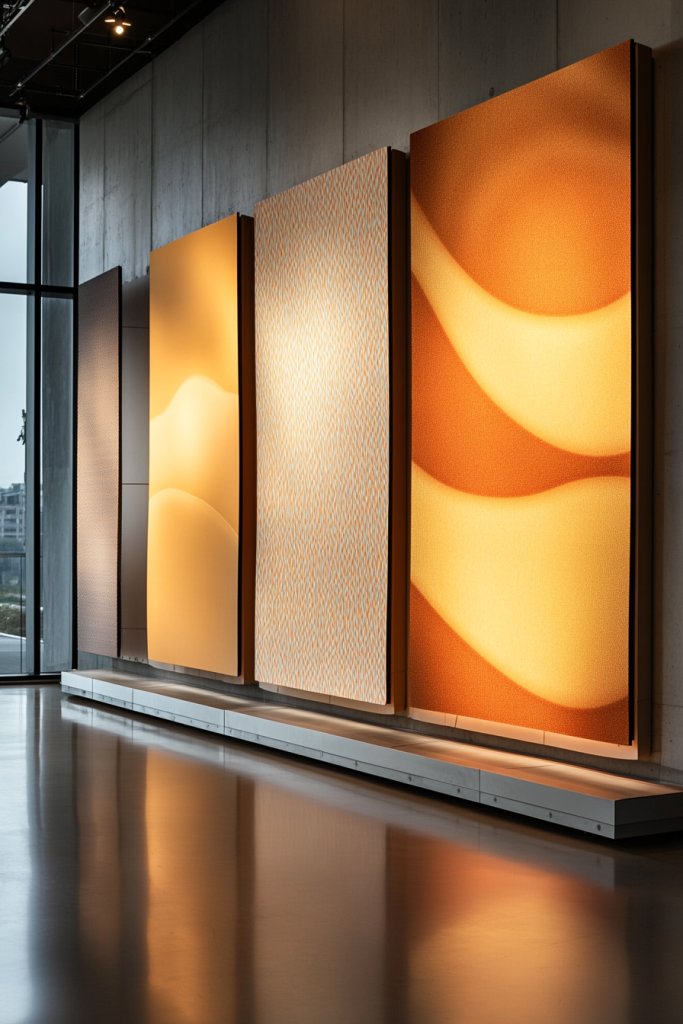
As kids grow, their interests and tastes change rapidly, making it hard to keep their room feeling fresh and relevant. Parents want a flexible, cost-effective solution to update decor without major renovations. Reversible wall panels offer an easy way to switch themes or colors, making the room adaptable and exciting. It’s a smart investment in growing with your child.
Picture a set of lightweight, durable panels with one side in a playful pattern or color, and the other in a more neutral or different fun design. They’re easily mounted and removed, allowing quick updates for birthdays, holidays, or new interests. When flipped, the room’s vibe shifts instantly—bright and energetic or calm and subdued. The panels can be arranged in various configurations for maximum versatility.
Choose panels with different themes—nature, space, animals, or abstract art—that suit your child’s current interests. Use neutral colors or patterns on the reverse side for a more grown-up look. Mix and match panel sizes and shapes for a customized layout. Seasonal or holiday-themed panels can be swapped in for added fun.
Install panels on a smooth, clean wall using adhesive, hooks, or mounting strips designed for lightweight materials. Arrange them in a pattern or random design, depending on your decor style. To switch themes, simply remove and flip the panels, then reattach. Keep spare panels in storage for future updates. Regularly clean the surfaces for a fresh look.
Create custom panels with your child’s drawings, photos, or themed designs using printable or fabric panels. Involve your child in decorating or choosing themes for each side, fostering ownership. Add decorative borders or DIY embellishments like stickers or fabric accents. It’s a fun, evolving way to keep their room lively and personal.
Reversible panels make decorating adaptable and fun, encouraging your child’s creativity and decision-making. They learn that their environment can evolve with their interests, fostering confidence and pride. Plus, it’s a cost-effective way to refresh the room repeatedly. Ready to flip your decor to suit every mood?
Conclusion
These diverse small kids’ bedroom ideas demonstrate how creativity and smart design can transform even the tiniest spaces into joyful, functional havens. Don’t hesitate to try out these inspiring concepts in your own home—your child’s dream room is just a few creative touches away! Embrace the challenge and watch your child’s space blossom into a playful sanctuary that sparks endless happiness and imagination.
Leave a Reply